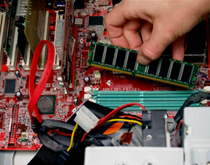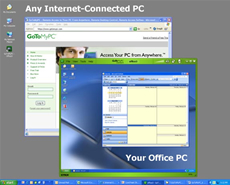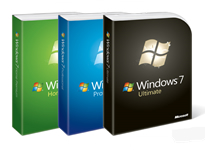Posts Tagged ‘tech support’
Friday, July 16th, 2010
 Hey, everyone. It’s Josh from Computer Fitness again. We are a Tech Support Company for Small and Medium businesses located in Reisterstown, MD. Hey, everyone. It’s Josh from Computer Fitness again. We are a Tech Support Company for Small and Medium businesses located in Reisterstown, MD.
So you want to build your own PC, huh? It’s an admirable goal to be sure. No more dealing with tech support and no wondering about the quality of the craftsmanship. It will be your machine. That’s all well and good, but building a PC isn’t something you want to rush into. It takes time to make sure you have all the details sorted out and the right parts required for successful assembly. Here are some suggestions for your journey to building a PC.
1) Check the dimensions of your parts – It happens all the time. People will buy a lot of parts that look cool, only to realize they don’t fit in the case they bought or that their screaming new graphics card takes up 4 spaces.
2) Double and Triple Check Socket Types – This is an especially important factor. When you purchase your CPU, make sure that it will work with your motherboard. AMD chips won’t work with an Intel motherboard, and vice versa.
3) RAM Speed – RAM comes in many flavors. First of all, make sure you get Desktop sized RAM not notebook RAM. It’s an easy mistake to make. Second, make sure that the speed matches your system. There are a variety of speeds out there, so get the right one for your system to ensure optimal performance.
4) Power Supply – This often gets overlooked. The power supply literally controls how much energy your PC can handle. If you plan on building a gaming PC or a graphic design PC that will utilize powerful hardware, don’t skimp on the power supply. Otherwise, you may find yourself unable to boot up the awesome machine you’ve just built.
-Josh
Computer Fitness
Onsite and Remote Tech Support

Tags: Building PCs, CPU, Parts, pc, power supply, RAM, tech support
Posted in Desktop - Workstation | No Comments »
Wednesday, June 23rd, 2010
 As seen at https://www.gotomypc.com/corp/technology.tmpl June 2010 Hey, everyone. It’s Josh from Computer Fitness again. We are a Tech Support Company for Small and Medium businesses located in Reisterstown, MD.
As we’ve talked about on one of our other blogs, remote use of a computer is a growing trend in today’s IT world. The article, located here, talks about some of the reasons why using RDC is a great idea. Here at Computer Fitness, we’re going to take a look at how to get this up and running on your home machine.
I’m going to assume that you’re using Windows for this part. Mac OS comes next. First, open up your Start menu. Next, you want to right click on My Computer. Next, click Manage. This will bring up a new screen with a lot of details about your computer. If you are using Windows XP, which a lot you probably are, you’ll see a tab labeled Remote.
On the Remote tab, there are two check boxes. The one you want to check here is under Remote Desktop and labeled “Allow Users to Connect Remotely to this Computer”. This computer can now be accessed remotely. If you want to add users that are allowed to use this privilege, which I recommend, just click the box labeled Select Remote Users. That will keep a tight control on the people using it.
Now, for Mac Users. This is pretty easy. Open up your System Preferences. Now, click on Sharing. Once that loads, you will see a number of options for sharing. Things like File Sharing will likely already enabled. You want to check the box labeled “Remote Management”. Once you do, you will be presented with a list of options for users taking control of the system. This provides granular control over users. This way, even if someone gets into your system, you still have some control if you aren’t there. Check the appropriate boxes and hit okay. As with Windows, you can select certain users to give access.
-Josh
Computer Fitness
Onsite and Remote Tech Support

Tags: computer, control, mac, pc, remote, sharing, tech support, users
Posted in Desktop - Workstation, Mac and PC | No Comments »
Thursday, May 13th, 2010
 Retail box Microsoft Windows 7: Home, Professional, and Ultimate Hello and welcome to Computer Fitness’ Blog! My name is Josh. You may know me from the Internet Beacon. We have a pretty cool blog over there. If you’re new to our sites, do check it out; there’s plenty more awesome over there. Computer Fitness is a tech support firm in Finksburg, MD. Our areas of expertise run the gamut from workstation repair to server maintenance.
Windows 7 is, in my opinion, the best Microsoft OS (operating system) yet. While it may look similar to Vista in some respects, the functionality and overall operability of Windows 7 is miles ahead of its forerunners. Given that all new machines are shipping with Windows 7, I though it appropriate to go over some neat tips and tricks for the OS. Some are cosmetic and some are functional.
Resizing Windows
I know the ability to change the size of a window to your liking is nothing new. In fact, it’s been around since, I believe, Windows 3.1. However, Microsoft introduced a rather cool new feature that automatically resizes them for you with either a mouse gesture or a keyboard shortcut. With this feature, you can either drag the window you want resized to a side of the screen or you can press the Windows key and the direction you want it go. By doing this, the window will take up whatever half of the screen it’s been sent to, allowing you to manage your desktop space even better than before!
Program Stacking in the Task Bar
It’s no secret that those of us who run a lot of programs on our PCs have our task bar filled up pretty quickly. Before you know it, it’s cluttered with a thousand and one Internet Explorer windows and you can never remember which one has what you really want on it. To remedy this, Microsoft changed the task bar. Now, instead of seeing a rectangle with the name of the program running, you see the icon with an illusion of stacking. That way, if you have multiple instances of the same program running, you can mouse over and see a preview of all the windows it uses. This makes it easier to get around your PC, and provides a cleaner look.
All in all, Windows 7 has added a lot of cool features, both behind the scenes and on the user interface. I highly recommend it for anyone looking to upgrade. NOTE: You cannot upgrade from XP to Win7. You will have to format your hard drive and then do a clean install. If you are unfamiliar with this, please consult an IT professional before beginning.
That’s all for this week! We’ll see you back next time for more Computer Fitness tips.
-Josh
Computer Fitness
Onsite and Remote Tech Support

Tags: computer, microsoft, task bar, tech support, Windows, Windows 7
Posted in Desktop - Workstation | No Comments »
Saturday, March 27th, 2010
 Hello and welcome to Computer Fitness’ Blog! My name is Josh. You may know me from the Internet Beacon. We have a pretty cool blog over there. If you’re new to our sites, do check it out; there’s plenty more awesome over there. Computer Fitness is a tech support firm in Finksburg, MD. Our areas of expertise run the gamut from desktop repair to server maintenance. This week I’d like to talk about RAM. Hello and welcome to Computer Fitness’ Blog! My name is Josh. You may know me from the Internet Beacon. We have a pretty cool blog over there. If you’re new to our sites, do check it out; there’s plenty more awesome over there. Computer Fitness is a tech support firm in Finksburg, MD. Our areas of expertise run the gamut from desktop repair to server maintenance. This week I’d like to talk about RAM.
Now, most people know what RAM does. If you don’t, here’s a quick rundown. RAM stands for Random Access Memory. Computer programs will take a chunk of it to run a program and then return it when they are finished. This is different from your Hard Drive, which stores data more or less permanently until you say otherwise.
Getting back to RAM, the more the better is generally true. However, there are cases when this may not be exactly true. While increasing the amount of RAM in your computer is almost always good, there are rules. There are two things I would like to caution users to take into account when purchasing RAM.
Teamwork is Key
RAM works best in pairs. When your PC/MAC uses RAM, it runs quicker and smoother when the amount of RAM you have is based on two similar chips. In essence, if you have 1 GB of RAM, you’re best speeds will come out of a pairing of two 512 MB chips. This rule applies as you increase the memory.
Ask Your Mother
Your motherboard, or Mainboard, is like the nervous system/brain of your computer, in that it deals with everything attached to the computer. What you want to take into account here is the maximum possible RAM that it can support. No technology is without limitations, and planning for the future is important. When ordering/building a new PC, check the maximum amount of RAM supported by the Motherboard.
If it is only twice what is currently in the PC, you may find yourself buying a new computer in 2-3 years rather than 5-6. The best part of desktop computers is the ease of upgrading. By not checking the computer’s limitations, you could end up spending a great deal more money than necessary.
Well, that’s all for this week. Come back next week for more tech tips!
-Josh
ComputerFitness.com
Baltimore Tech Support

Tags: computer, pc, RAM, support, tech support
Posted in Hardware Overview | 1 Comment »
|
 Hey, everyone. It’s Josh from Computer Fitness again. We are a Tech Support Company for Small and Medium businesses located in Reisterstown, MD.
Hey, everyone. It’s Josh from Computer Fitness again. We are a Tech Support Company for Small and Medium businesses located in Reisterstown, MD.






 Hello and welcome to
Hello and welcome to 

